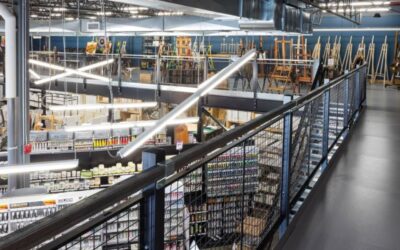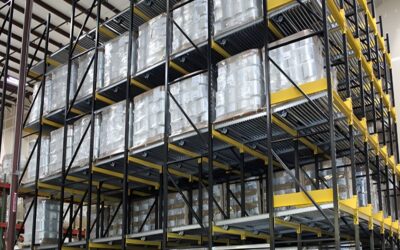The Time to Revolutionize Operations with Warehouse Space Optimization

In the dynamic landscape of modern business, optimizing warehouse space has become crucial for success. The efficient use of warehouse space increases productivity and contributes significantly to cost savings. In this blog post, we will delve into the various strategies and technologies businesses can leverage to optimization warehouse space.
The Importance of Warehouse Space Optimization
Before diving into the strategies, it’s essential to comprehend why warehouse space utilization is a business’s priority. Efficient warehouse space utilization directly impacts operational costs, inventory management, and customer satisfaction.
Reducing Operational Costs through Smart Design
One of the primary benefits of space optimization is the reduction in operational costs. A well-designed warehouse layout minimizes the distance workers and vehicles travel, leading to improved efficiency. Automation and smart technology further streamline operations, allowing quicker order fulfillment and reduced labor costs.
Effective Inventory Management
Warehouse optimization for space is closely linked to effective inventory management. Secondly, by organizing products strategically, businesses can minimize stockouts and overstock situations. This prevents revenue loss and contributes to a smoother supply chain. Implementing technologies like RFID and barcode systems improves real-time visibility, enabling better control over inventory levels.
Enhancing Customer Satisfaction
In the age of e-commerce, fast and accurate order fulfillment is paramount for customer satisfaction. A well-optimized warehouse ensures that products are readily available for shipping, reducing lead times. This results in timely deliveries, ultimately improving the customer experience and fostering loyalty.
Strategies for Warehouse Space Optimization
Now that we understand the significance, let’s explore practical strategies for warehouse space optimization.
Vertical Space Utilization
Many warehouses underutilize vertical space. Implementing taller storage systems, such as high racks and mezzanines, maximizes the use of available cubic footage. Besides this, automated storage and retrieval systems (AS/RS) can efficiently handle vertical storage. Hence, ensuring easy accessibility and retrieval of goods.
Dynamic Slotting Systems
Implementing a dynamic slotting system involves continuously evaluating and adjusting product placement based on demand and picking frequency. This strategy ensures that fast-moving items are easily accessible, reducing travel time for workers and improving overall efficiency.
Cross-Docking
Cross-docking is a logistics strategy where incoming goods are unloaded from an inbound vehicle and directly loaded onto an outbound vehicle with minimal storage time. This reduces the need for extensive storage space and accelerates order fulfillment, particularly for perishable goods or high-demand products.
Lean Inventory Practices
Adopting lean inventory practices involves maintaining the minimum stock required to meet customer demand. Businesses can free up valuable warehouse space and minimize carrying costs by reducing excess inventory. Moreover, real-time analytics and demand forecasting tools are crucial in implementing effective lean inventory practices.
Warehouse Automation
Automation technologies, such as conveyor systems, robotic picking systems, and automated guided vehicles (AGVs), significantly contribute to space optimization. These technologies improve the speed and accuracy of order fulfillment while efficiently utilizing space. Additionally, they allow for 24/7 operations, further optimizing resource utilization.
Technology Integration for Enhanced Optimization
Warehouse Management Systems (WMS)
A robust WMS is the backbone of storage optimization. It provides real-time visibility into inventory, streamlines order processing, and optimizes storage allocation. WMS can integrate with other technologies, such as RFID and barcode systems, to ensure accurate tracking and efficient management of goods.
Data Analytics for Continuous Improvement
Implementing data analytics tools allows businesses to analyze warehouse performance and identify areas for improvement continually. Organizations can make informed decisions regarding space utilization, inventory levels, and operational efficiency by leveraging data insights. Further, this iterative process ensures ongoing optimization and adaptability to changing market dynamics.
Conclusion
Latest Blogs
Important Questions To Ask Before Hiring Mezzanine Builders
To achieve a layout that boosts work productivity, find out what kind of questions you should ask your mezzanine builders before they work in your warehouse.
Important Questions To Ask Before Hiring Mezzanine Builders
To achieve a layout that boosts work productivity, find out what kind of questions you should ask your mezzanine builders before they work in your warehouse.
Effective Strategies for Efficient Pallet Rack Installation
To optimize your warehouse layout, discover how to efficiently install a pallet rack system that maintains and improves work performance across your business.
How Warehouse Design Consultants Improve Operations
Need to restructure your warehouse to boost productivity and workflow? Partner with a trusted design consultant! But first, learn more about their services.
Questions?
Let’s Chat About Your Warehouse Project Today!
Or all us at 515-635-1555
Save time. We will contact you
Provide your details, and we’ll help you find exactly what you need


